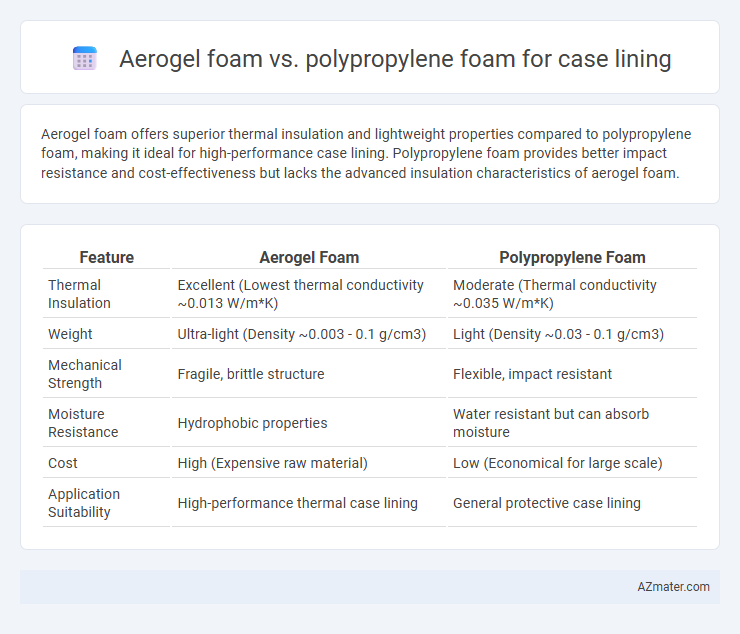Aerogel foam offers superior thermal insulation and lightweight properties compared to polypropylene foam, making it ideal for high-performance case lining. Polypropylene foam provides better impact resistance and cost-effectiveness but lacks the advanced insulation characteristics of aerogel foam.
Table of Comparison
| Feature | Aerogel Foam | Polypropylene Foam |
|---|---|---|
| Thermal Insulation | Excellent (Lowest thermal conductivity ~0.013 W/m*K) | Moderate (Thermal conductivity ~0.035 W/m*K) |
| Weight | Ultra-light (Density ~0.003 - 0.1 g/cm3) | Light (Density ~0.03 - 0.1 g/cm3) |
| Mechanical Strength | Fragile, brittle structure | Flexible, impact resistant |
| Moisture Resistance | Hydrophobic properties | Water resistant but can absorb moisture |
| Cost | High (Expensive raw material) | Low (Economical for large scale) |
| Application Suitability | High-performance thermal case lining | General protective case lining |
Introduction to Aerogel Foam and Polypropylene Foam
Aerogel foam boasts an ultra-lightweight structure with exceptional thermal insulation properties, making it ideal for case lining that requires temperature regulation and impact resistance. Polypropylene foam provides a durable, flexible, and cost-effective cushioning solution with excellent moisture resistance and compression recovery, widely used for protective packaging and case inserts. Both materials serve specific needs in case lining applications, with aerogel foam excelling in thermal management and polypropylene foam offering superior mechanical protection.
Material Composition and Structure
Aerogel foam, composed primarily of silica-based nanoparticles forming an ultralight, porous matrix, offers exceptional thermal insulation and low density ideal for case lining applications. Polypropylene foam consists of polypropylene polymer chains arranged in a cellular, closed-cell structure that provides durability, impact resistance, and moisture resistance. The distinct composition and nanoscale structure of aerogel foam deliver superior insulating properties compared to the more flexible and cost-effective polypropylene foam, influencing the choice based on thermal performance versus mechanical cushioning requirements.
Thermal Insulation Properties Comparison
Aerogel foam offers superior thermal insulation with a thermal conductivity as low as 0.013 W/m*K, significantly outperforming polypropylene foam, which typically ranges around 0.035 to 0.045 W/m*K. This makes aerogel foam highly effective for case lining applications requiring maximum heat resistance and minimal thermal transfer. Polypropylene foam, while cost-effective and lightweight, provides moderate insulation but lacks the advanced thermal barrier capabilities of aerogel foam.
Impact Resistance and Shock Absorption
Aerogel foam offers superior impact resistance and shock absorption compared to polypropylene foam due to its ultra-lightweight structure and high energy dissipation capabilities. Aerogel's nanoporous composition effectively disperses impact forces, making it ideal for delicate electronics or sensitive equipment in case lining. Polypropylene foam provides moderate cushioning but lacks the advanced compression recovery and vibration dampening qualities found in aerogel foams.
Weight and Density Differences
Aerogel foam exhibits an ultra-low density typically around 0.01 to 0.3 g/cm3, making it one of the lightest solid materials suitable for case lining, significantly reducing overall weight compared to polypropylene foam which has a density ranging from 0.9 to 1.2 g/cm3. The low density of aerogel foam enhances portability and shock absorption without adding bulk, whereas polypropylene foam, though denser and heavier, offers robust structural support and durability. Weight-conscious applications benefit from aerogel foam's superior lightweight properties, while polypropene is preferred where higher impact resistance and cost-efficiency are required.
Moisture and Chemical Resistance
Aerogel foam exhibits superior moisture resistance due to its hydrophobic properties, effectively repelling water and preventing moisture absorption, which makes it ideal for case linings exposed to damp environments. Polypropylene foam also offers good moisture resistance but can absorb chemicals and degrade more quickly when in contact with harsh solvents or oils. For chemical resistance, aerogel foam outperforms polypropylene by maintaining structural integrity and insulating properties even under exposure to aggressive chemicals, enhancing the durability and protection of sensitive equipment inside cases.
Durability and Longevity
Aerogel foam offers superior durability due to its rigid structure and high resistance to compression, maintaining integrity under repeated impacts better than polypropylene foam. Polypropylene foam provides flexibility and moderate wear resistance but tends to degrade faster with prolonged pressure and environmental exposure. For case lining, aerogel foam ensures longer-lasting protection, especially in demanding conditions where maintaining shape and cushioning over time is critical.
Environmental Impact and Sustainability
Aerogel foam exhibits superior thermal insulation properties while being lightweight, contributing to reduced energy consumption and lower carbon footprints during manufacturing and transportation compared to conventional materials. Polypropylene foam, although recyclable and widely used, relies heavily on fossil fuels and generates more greenhouse gas emissions over its lifecycle. Choosing aerogel foam for case lining enhances sustainability by minimizing environmental impact and promoting eco-friendly material utilization.
Cost Analysis for Case Lining Applications
Aerogel foam offers superior thermal insulation but comes with significantly higher material costs compared to polypropylene foam, making it less economical for large-scale case lining applications. Polypropylene foam provides a cost-effective solution with adequate cushioning and moderate insulation properties, resulting in lower overall expenses for manufacturers. Cost analysis indicates that polypropylene foam is preferred when budget constraints outweigh the need for advanced thermal performance in protective case linings.
Best Use Cases: Selecting the Right Foam for Your Needs
Aerogel foam excels in case lining where superior thermal insulation and lightweight protection against extreme temperatures are critical, making it ideal for sensitive electronics or medical equipment. Polypropylene foam offers excellent shock absorption, chemical resistance, and cost-effectiveness, suited for packaging heavy-duty tools or industrial components requiring robust impact protection. Choosing between these foams depends on prioritizing insulation performance versus durability and budget constraints for your specific case lining application.

Infographic: Aerogel foam vs Polypropylene foam for Case lining
 azmater.com
azmater.com